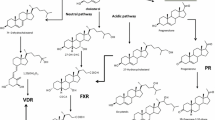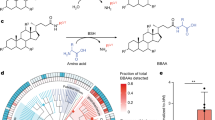Abstract
The ability of a human colonic epithelial cell line (CaCo-2) to synthesize leukotriene B4 (LTB4) in response to bile salt stimulation was examined, as was the dependency of such stimulation on the hydrophobic-hydrophilic balance of the bile salts. We demonstrate for the first time in this human intestinal epithelial cell line the ability of bile salts to stimulate synthesis of LTB4. CaCo-2 cell monolayers were incubated with a series of bile salts ranging in concentration from 0.5 µM to 1 mM. This resulted in a dose- and hydrophobicity-dependent increase in LTB4 synthesis. Hydrophobic bile salts (glycine and taurine conjugates of lithocholate and deoxycholate) caused LTB4 synthesis to be stimulated 27% and 35%, respectively, above control levels. In contrast, hydrophilic bile salts (glycine and taurine conjugates of ursodeoxycholate) increased LTB4 synthesis only 11.2% and 16.1%. Under basal conditions pretreatment with dexamethasone significantly inhibited bile salt-induced LTB4 synthesis by 38% compared to control. With more hydrophobic bile salts, chenodeoxycholate and deoxycholate, dexamethasone inhibited LTB4 synthesis to levels significantly below those observed with dexamethasone under basal conditions. Unlike A23187 calcium ionophore-induced LTB4 synthesis, bile salt-induced stimulation of LTB4 synthesis was not found to be dependent on the presence of extracellular calcium. Variations in bile salt stimulation of LTB4 by intestinal epithelial cells could be important in modulating cellular responses. The synthesis of chemotactic factors, such as LTB4, by the human colonic adenocarcinoma epithelial cell line now needs to be extended to normal human intestinal epithelium, as it may play a role in many of the functional disturbances which characterize intestinal inflammatory conditions.
Similar content being viewed by others
References
Scholmerich J, Becher M-S, Schmidt K, Schubert R, Kremer B, Feldhaus S, Gerok W: Influence of hydroxylation and conjugation of bile salts on their membrane-damaging properties—studies on isolated hepatocytes and lipid membrane vesicles. Hepatology 4:661–666, 1984
Roda A, Minutello A, Angellotti MA, Fini A: Bile acid structure-activity: Evaluation of bile acid lipophilicity using 1-octanol/water partition coefficient and reverse phase HPLC. J Lipid Res 31:1433–1443, 1990
Armstrong MJ, Carey MC: The hydrophobic-hydrophilic balance of bile salts. Inverse correlation between reverse-phase high performance liquid chromotagraphic mobilities and micellar cholesterol-solubilizing capacities. J Lipid Res 23:7–80, 1982
Attilli AF, Angelico M, Cantaforra A, Alvaro D, Capocaccia L: Bile acid induced liver toxicity: Relation to the hydrophobic-hydrophilic balance of bile salts. Med Hypoth 19:57–69, 1986
Schubert R, Schmidt KH: Structural changes in vesicle membranes and mixed micelles of various lipid compositions after binding of different bile salts. Biochemistry 27:8787–8794, 1988
Stenson WF: Role of eicosanoids as mediators in inflammatory bowel disease. Scand J Gastroenterol 25(suppl 172):13–18, 1990
Nielsen OH, Ahnfelt-Ronne I, Elmgreen J: Abnormal metabolism of arachidonic acid in chronic inflammatory bowel disease: Enhanced release of leukotriene B4 from activated neutrophils. Gut 28:181–185, 1987
Pinto M, Robine-Leon S, Appay M-D, Kedinger N, Triadou E, Dussaulx E, Lacroix B, Simon-Assmann P, Haffen K, Fogh J, Zweibaum A: Entrocyte-like differentiation and polarization of the human colon carcinoma cell line CaCo-2 in culture. Biol Cell 47:323–330, 1983
Chantret I, Barbat A, Dussaulx E, Brattain MG, Zweibaum A: Epithelial polarity, villin expression, and enterocyte differentiation of cultured human colon carcinoma cells: A survey of twenty cell lines. Cancer Res 48:1936–1942, 1988
Dias VC, Wallace JL, Parsons HG: Modulation of cellular phospholipid fatty acids and leukotriene B4 synthesis in the human intestinal cell (CaCo-2). Gut 33:622–627, 1992
Craven PA, DeRubertis FR: Profiles of eicosanoid production of superficial and proliferative colonic epithelial cells and sub-epithelial colonic tissue. Prostanglandins 32:387–399, 1986
Amador E, Dorfman LE, Wacker WEC: Serum lactic dehydrogenase activity: An analytical assessment of current assays. Clin Chem 9:391–395, 1963
Wallace JL, Keenan CM: An orally active inhibitor of leukotriene synthesis accelerates healing in a rat model of colitis. Am J Physiol 258:G527–G534, 1990
Borgeat P, Picard S, Vallerand P, Bourgoin S, Odeimat A, Sirois P, Poubelle PE: Automated on-line extraction and profiling of lipoxygenase products of arachidonic acid by high-performance liquid chromatography. Methods Enzymol 187:98–116, 1990
Bradford MM: A rapid and sensitive method for the quantitation of microgram quantities of protein utilizing the principle of protein-dye binding. Anal Biochem 72:248–254, 1976
Chilton FH: Assays for measuring arachidonic acid release from phospholipids. Methods Enzymol 197:166–182, 1991
Blackwell GJ, Flower RJ: Inhibition of Phospholipase. Br Med Bul 39:260–264, 1983
Anwer MS, Little JM, Oelberg DG, Zimniak P, Lester R: Effect of bile acids on calcium efflux from isolated rat hepatocytes and perfused rat livers. Proc Soc Exp Biol Med 191:147–152, 1989
Combettes L, Berthon B, Doucet E, Erlinger S, Claret M: Bile acids mobilize internal Ca2+ independently of external Ca2+ in rat hepatocytes. Eur J Biochem 190:619–623, 1990
DeRubertis FR, Craven PA, Saito R: Bile salt stimulation of colonic epithelial proliferation—Evidence for involvement of lipoxygenase products. J Clin Invest 74:1614–1624, 1984
Hay DW, Carey MC: Chemical species of lipids in bile. Hepatology 12:6S-16S, 1990
Quist RG, Ton-Nu H-T, Lillenau J, Hofmann AF, Barrett KE: Bile salts cause histamine release from mast cells. Gastroenterology 101:1–11, 1991
Lichtenberg D, Robson RJ, Dennis EA: Solubilization of phospholipids by detergents. Biochim Biophys Acta 737:285–304, 1983
Lobos EA, Sharon P, Stenson WF: Chemotactic activity in inflammatory bowel disease. Role of leukotriene B4. Dig Dis Sci 32:1380–1388, 1987
Sharon P, Stenson WF: Enhanced synthesis of leukotriene B4 by colonic mucosa in inflammatory bowel disease. Gastroenterology 86:453–460, 1984
Zifroni A, Treves AJ, Sachar DB, Rachmilewitz D: Prostanoid synthesis by cultured epithelial and mononuclear cells in inflammatory bowel disease. Gut 24:659–664, 1983
Dreyling KW, Hoppe U, Peskar BA, Morgenroth K, Kozuschek W, Peskar BM: Leukotriene synthesis by human gastrointestinal tissues. Biochim Biophys Acta 878:184–193, 1986
Dias VC, Fitzsimmons BF, Parsons HG: Eicosapentaenoic acid inhibits the arachidonic acid content of CaCo-2 microvillous membrane lipids. FASEB J 4:A797, 1990 (abstract)
Dias VC, Borkowski JM, Parsons HG: Eicosapentaenoic acid modulates the Δ6 and Δ5 desaturase activity in the intestinal CaCo-2 cell line. Gastroenterology 100:A824, 1991 (abstract)
Dias VC, Keenan CM, Wallace JL, Parsons HG: Presence of 5-lipoxygenase activity in the human intestinal CaCo-2 cell line. FASEB J5:A1272, 1991 (abstract)
Dennis EA: Modification of the arachidonic acid cascade through phospholipase A2 dependent mechanisms. Adv Prostaglandin Thromboxane Leukotriene Res 20:217–223, 1990
Flower RJ: Lipocortins and the mechanisms of action of the glucocorticoids. Br J Pharmacol 94:987–1015, 1988
Nishida T, Miwa H, Shigematsu A, Yamamoto M, Lida M, Fujishima M: Increased arachidonic acid composition of phospholipids in colonic mucosa from patients with active ulcerative colitis. Gut 28:1002–1007, 1987
Craven PA, DeRobertis FR: Profiles of icosanoid production by superficial and proliferative colonic epithelial cells and sub-epithelial colonic tissue. Prostaglandins 32:387–399, 1986
Author information
Authors and Affiliations
Additional information
This work was funded by the Canadian Foundation for Ileitis and Colitis (CFIC).
Rights and permissions
About this article
Cite this article
Dias, V.C., Shaffer, E.A., Wallace, J.L. et al. Bile salts determine leukotriene B4 synthesis in a human intestinal cell line (CaCo-2). Digest Dis Sci 39, 802–808 (1994). https://doi.org/10.1007/BF02087427
Received:
Revised:
Accepted:
Issue Date:
DOI: https://doi.org/10.1007/BF02087427




